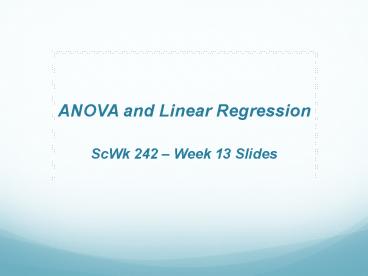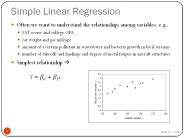ANOVA and Linear Regression ScWk 242 - PowerPoint PPT Presentation
Title:
ANOVA and Linear Regression ScWk 242
Description:
ANOVA and Linear Regression ScWk 242 Week 13 Slides ANOVA Analysis of Variance Analysis of variance is used to test for differences among more than two ... – PowerPoint PPT presentation
Number of Views:110
Avg rating:3.0/5.0
Title: ANOVA and Linear Regression ScWk 242
1
ANOVA and Linear RegressionScWk 242 Week 13
Slides
2
ANOVA Analysis of Variance
- Analysis of variance is used to test for
differences among more than two populations. It
can be viewed as an extension of the t-test we
used for testing two population means. - The specific analysis of variance test that we
will study is often referred to as the oneway
ANOVA. ANOVA is an acronym for ANalysis Of
VAriance. The adjective oneway means that there
is a single variable that defines group
membership (called a factor). Comparisons of
means using more than one variable is possible
with other kinds of ANOVA analysis.
3
Logic of ANOVA
- The logic of the analysis of variance test is the
same as the logic for the test of two population
means. - In both tests, we are comparing the differences
among group means to a measure of dispersion for
the sampling distribution. - In ANOVA, differences of group means is computed
as the difference for each group mean from the
mean for all subjects regardless of group. The
measure of dispersion for the sampling
distribution is a combination of the dispersion
within each of the groups. - Dont be fooled by the name. ANOVA does not
compare variances.
4
ANOVA Example 1 Treating Anorexia Nervosa
5
ANOVA Example 2 Diet vs. Weight Comparisons
Treatment Group N Mean weight in pounds
Low Fat 5 150
Normal Fat 5 180
High Fat 5 200
15
6
Uses of ANOVA
- The one-way analysis of variance for independent
groups applies to an experimental situation where
there might be more than two groups. The t-test
was limited to two groups, but the Analysis of
Variance can analyze as many groups as you want. - Examine the relationship between variables when
there is a nominal level independent variable has
3 or more categories and a normally distributed
interval/ratio level dependent variable.
Produces an F-ratio, which determines the
statistical significance of the result. - Reduces the probability of a Type I error (which
would occur if we did multiple t-tests rather
than one single ANOVA).
7
ANOVA - ASSUMPTIONS LIMITATIONS
- Assumptions
- NORMALITY ASSUMPTION.
- The dependent variable can be modeled as a
normal population. - HOMOGENEITY OF VARIANCE.
- The dispersion of any populations in our model
will be relatively equal. - Limitations
- The amount of variance for each sample among the
dependent variables is relatively equivalent.
8
Linear Regression - Definition
- What is Linear Regression? In correlation, the
two variables are treated as equals. In
regression, one variable is considered
independent (predictor) variable (X) and the
other the dependent (outcome) variable Y. - Prediction If you know something about X, this
knowledge helps you predict something about Y.
9
Linear Regression - Example
- Does there seem to be a linear relationship in
the data? - Is the data perfectly linear?
- Could we fit a line to this data?
10
Linear vs. Curvilinear Relationships
Linear relationships
Curvilinear relationships
Y
Y
X
X
Y
Y
X
X
- Slide from Statistics for Managers Using
Microsoft Excel 4th Edition, 2004 Prentice-Hall
11
Strong vs. Weak Linear Correlations
Strong relationships
Weak relationships
Y
Y
X
X
Y
Y
X
X
- Slide from Statistics for Managers Using
Microsoft Excel 4th Edition, 2004 Prentice-Hall
12
Simple Linear Regression
- Predicting a criterion value based upon a known
predictor(s) value. - Predictor variable (X) what is used as the basis
for the prediction (test score, frequency of
behavior, amount of something). - Criterion variable (Y) what we want to know
(self-esteem, graduate school GPA, violent
tendencies).
13
Limitations - Simple Linear Regression
- Interval or Ratio data only
- Can only use predictor values that lie within the
existing data range (outliers do not work). - Assume normally distributed values for both the
predictor and the criterion variables.
14
Interpreting Results - Linear Regression
- Know what you are predicting. It should make
sense. - Value of prediction is directly related to
strength of correlation between the variables. As
r decreases, the accuracy of prediction
decreases - Y 3.5 6.8(X), For every unit increase in X,
there will be a 6.8 unit increase in Y. The
client's education (X) and assertiveness level
(Y) for each 1 year increase in a client's
education level, her assertiveness level will
increase by 6.8 points.
15
Multivariate Analysis
- So far we have tended to concentrate on two-way
relationship (such as chi-square and t-tests).
But we have started to look at about three-way
relationships. - Social relationships and phenomena are usually
more complex than is allowed for in only a
bivariate analysis. - Multivariate analyses are thus commonly used as a
reflection of this complexity.
16
Multivariate Analysis - Summary
- Multivariate analyses can utilize a variety of
techniques (depending on the form of the data,
research questions to be addressed, etc., in
order to determine whether the relationship
between two variables persists or is altered when
we control for a third (or fourth, or fifth...)
variable. - Multivariate analysis can also enable us to
establish which variable(s) has/have the greatest
impact on a dependent variable e.g. Is sex
more important than race in determining income?
- It is often important for a multivariate analysis
to check for interactions between the effects of
independent variables, as discussed earlier under
the heading of specification.































